FLARE: A Framework for the Finite Element Simulation of Electromagnetic Interference on Buried Metallic Pipelines
Abstract
:1. Introduction
Concerns over Metallic Pipelines Integrity
2. Numerical Model
2.1. Formulations
2.1.1. Static
2.1.2. Sinusoidal Steady-State (Time Harmonic)
2.1.3. Time-Domain
Time-Stepping Method
Inverse-Laplace Transform Method
2.2. Vectorized Right-Hand Side Assembly Routine
- %% Assembly of K_t auxiliary matrix
- % concatenated rows of the connectivity matrix C
- ii = reshape(C’,[], 1);
- % n_el: number of mesh elements
- jj = repelem(1:n_el,3); % 1 1 1 2 2 2 3 3 3 ...
- % n_p: number of mesh points
- K_t = sparse(ii,jj,1,n_p,n_el); % assemble ones in a n_p X
- n_el matrix with rows and column indices given by ii and jj arrays
2.3. Software Structure
- unit_circle; % import mesh file
- ndom = num_regions(msh); % count number of regions (domains)
- opts.tag_boundary = 1; % set domain boundary on edges marked
- with tag=1 in msh
- [opts.materials] = set_materials(’mesh_unit_circle’,ndom); %
- define material properties
- opts.ProblemKind = ’Electrostatic’; % [Electrostatic][
- Magnetostatic][QMagnetostaticSin][MagTimeDependent] % set
- the kind of problem to be solved
- opts.source = 1; % unit charge density, uniformly distributed
- function [material] = set_materials(flag,ndom)
- switch flag
- case (’mesh_unit_circle’)
- material(1) = ’air’;
- ...
- function [Mprop] = MatLib(MatKind)
- % prop(1) = material relative permittivity [Adim]
- % prop(2) = material relative permeability [Adim]
- % prop(3) = material electric conductivity [S/m]
- switch MatKind
- case “air”
- Mprop = [1, 1, 0];
- ...
- [out] = fesolve(msh,opts); % setup and compute solution
- x = msh.POS(:,1); y = msh.POS(:,2); % get mesh coordinates
- trisurf(msh.TRIANGLES(:,1:3),x,y,out.field.phi,out.field.phi)
3. Results and Discussion
3.1. Corridor Geometry
3.2. Time-Harmonic Analysis
3.3. Lightning-Induced Phase Conductor Current
3.4. COMSOL Simulation Settings
3.5. Numerical Validation of the Inverse-Laplace Approach
3.6. Comparison between Different Numerical Inversion Routines
4. Conclusions
Author Contributions
Funding
Data Availability Statement
Conflicts of Interest
References
- Lucca, G. AC interference from a faulty power line on nearby buried pipelines: Influence of the surface layer soil. IET Sci. Meas. Technol. 2020, 14, 225–232. [Google Scholar] [CrossRef]
- Zhang, Y.; Weng, W.G. Bayesian network model for buried gas pipeline failure analysis caused by corrosion and external interference. Reliab. Eng. Syst. Saf. 2020, 203, 107089. [Google Scholar] [CrossRef]
- Cetin, O.; Duzkaya, H.; Taplamacioglu, M.C. Analysis of Transmission Line Electromagnetic Interference on Touch and Step Voltages on Buried Gas Pipeline under Different Shielding and Resistivity Conditions. In Proceedings of the 2021 13th International Conference on Electronics, Computers and Artificial Intelligence (ECAI), Pitesti, Romania, 1–3 July 2021; pp. 1–4. [Google Scholar] [CrossRef]
- Brenna, A.; Beretta, S.; Ormellese, M. AC Corrosion of Carbon Steel under Cathodic Protection Condition: Assessment, Criteria and Mechanism. A Review. Materials 2020, 13, 2158. [Google Scholar] [CrossRef]
- Al-Gabalawy, M.; Mostafa, M.A.; Hamza, A.S. Implementation of different intelligent controllers for mitigating the AC corrosion of metallic pipelines considering all HVOHTLs operation conditions. ISA Trans. 2021, 117, 251–273. [Google Scholar] [CrossRef]
- Muresan, A.; Papadopoulos, T.A.; Czumbil, L.; Chrysochos, A.I.; Farkas, T.; Chioran, D. Numerical Modeling Assessment of Electromagnetic Interference Between Power Lines and Metallic Pipelines: A Case Study. In Proceedings of the 2021 9th International Conference on Modern Power Systems (MPS), Cluj-Napoca, Romania, 16–17 June 2021; pp. 1–6. [Google Scholar] [CrossRef]
- Luo, Y.; Lin, N.; Zhou, S.; Li, S.; Wang, H. Effects of electromagnetic interference and crevice on corrosion of natural gas pipelines. IOP Conf. Ser. Earth Environ. Sci. 2021, 675, 012061. [Google Scholar] [CrossRef]
- Liu, H.; Li, Q.; Li, H.; Xue, Z.; Han, M.; Liu, L. Characteristics and effects of electromagnetic interference from UHVDC and geomagnetic storms on buried pipelines. Int. J. Electr. Power Energy Syst. 2021, 125, 106494. [Google Scholar] [CrossRef]
- Charalambous, C.A.; Nikolaidis, A.I. Complete Method to Assess the DC Corrosion Impact on Pipeline Systems During the Planning and Approval Stages of HVDC Systems With Earth Current Return. IEEE Access 2022, 10, 127550–127562. [Google Scholar] [CrossRef]
- Li, Y.; Liu, L.; Ya, S.; Long, Y.; Li, K.; Cao, X. Research on the Protection Principle and Influencing Factors of Zinc Strip on Buried Pipelines around AC Subway. In Proceedings of the 2022 IEEE International Conference on High Voltage Engineering and Applications (ICHVE), Chongqing, China, 25–29 September 2022; pp. 1–4. [Google Scholar] [CrossRef]
- Ma, C.; Liu, C. Influence of Pipeline Insulation Leakage Points on the Distribution of Geomagnetically Induced Current and Pipe-Soil Potential. IEEE Access 2019, 7, 147470–147480. [Google Scholar] [CrossRef]
- CIGRE. Guide on the Influence of High Voltage AC Power Systems on Metallic Pipelines; Technical Report; Cigré Working Group 36.02: Paris, France, 1995. [Google Scholar]
- Taflove, A.; Dabkowski, J. Prediction Method for Buried Pipeline Voltages Due to 60 Hz AC Inductive Coupling Part I—Analysis. IEEE Trans. Power Appar. Syst. 1979, PAS-98, 780–787. [Google Scholar] [CrossRef]
- Dabkowski, J.; Taflove, A. Prediction Method for Buried Pipeline Voltage Due to 60 Hz AC Inductive Coupling Part II—Field test Verification. IEEE Trans. Power Appar. Syst. 1979, PAS-98, 788–794. [Google Scholar] [CrossRef]
- Machczynski, W.; Budnik, K.; Szymenderski, J. Assessment of DC traction stray currents effects on nearby pipelines. COMPEL Int. J. Comput. Math. Electr. Electron. Eng. 2016, 35, 1468–1477. [Google Scholar] [CrossRef]
- Cristofolini, A.; Popoli, A.; Sandrolini, L. A comparison between Carson’s formulae and a 2D FEM approach for the evaluation of AC interference caused by overhead power lines on buried metallic pipelines. Prog. Electromagn. Res. 2017, 79, 39–48. [Google Scholar] [CrossRef]
- Lucca, G. Influence of steel non-linearity in assessing 50–60 HZ interference on pipelines. Prog. Electromagn. Res. M 2018, 74, 1–10. [Google Scholar] [CrossRef]
- Ametani, A.; Yoneda, T.; Baba, Y.; Nagaoka, N. An Investigation of Earth-Return Impedance Between Overhead and Underground Conductors and Its Approximation. IEEE Trans. Electromagn. Compat. 2009, 51, 860–867. [Google Scholar] [CrossRef]
- Dawalibi, F.P.; Southey, R.D. Analysis of electrical interference from power lines to gas pipelines. I. Computation methods. IEEE Trans. Power Deliv. 1989, 4, 1840–1846. [Google Scholar] [CrossRef]
- Christoforidis, G.C.; Labridis, D.P.; Dokopoulos, P.S. A hybrid method for calculating the inductive interference caused by faulted power lines to nearby buried pipelines. IEEE Trans. Power Deliv. 2005, 20, 1465–1473. [Google Scholar] [CrossRef]
- Schoonjans, B.; Deconinck, J. Calculation of HVAC inductive coupling using a generalized BEM for Helmholtz equations in unbounded regions. Int. J. Electr. Power Energy Syst. 2017, 84, 242–251. [Google Scholar] [CrossRef]
- Micu, D.D.; Christoforidis, G.C.; Czumbil, L. AC interference on pipelines due to double circuit power lines: A detailed study. Electr. Power Syst. Res. 2013, 103, 1–8. [Google Scholar] [CrossRef]
- Cristofolini, A.; Popoli, A.; Sandrolini, L. Numerical Modelling of Interference from AC Power Lines on Buried Metallic Pipelines in Presence of Mitigation Wires. In Proceedings of the 2018 IEEE International Conference on Environment and Electrical Engineering and 2018 IEEE Industrial and Commercial Power Systems Europe (EEEIC/I&CPS Europe), Palermo, Italy, 12–15 June 2018; pp. 1–6. [Google Scholar] [CrossRef]
- Popoli, A.; Sandrolini, L.; Cristofolini, A. Finite Element Analysis of Mitigation Measures for AC Interference on Buried Pipelines. In Proceedings of the 2019 IEEE International Conference on Environment and Electrical Engineering and 2019 IEEE Industrial and Commercial Power Systems Europe (EEEIC/I&CPS Europe), Genova, Italy, 11–14 June 2019; pp. 1–5. [Google Scholar] [CrossRef]
- Popović, L.M. 7—Inductive influence of high-voltage and extra-high voltage lines on surrounding metal installations. In Relevant Characteristics of Power Lines Passing through Urban Areas; Popović, L.M., Ed.; Academic Press: Cambridge, MA, USA, 2022; pp. 151–189. [Google Scholar] [CrossRef]
- Haynes, G.J.; Manning, T.; Baete, C.; Barton, L. Variances in pipeline AC interference computational modeling. In Proceedings of the Corrosion Conference and Expo 2019, Nashville, TN, USA, 24–28 March 2019. [Google Scholar]
- Southey, R.D.; Dawalibi, F.P.; Vukonich, W. Recent advances in the mitigation of AC voltages occurring in pipelines located close to electric transmission lines. IEEE Trans. Power Deliv. 1994, 9, 1090–1097. [Google Scholar] [CrossRef]
- Andolfato, R.; Cuccarollo, D.; Fara, I. Electromagnetic Interferences between Power Systems and Pipelines. Field vs. Circuit Theory Based Models; NACE International: Milano, Italy, 2021. [Google Scholar]
- Christoforidis, G.C.; Labridis, D.P.; Dokopoulos, P.S. Inductive interference on pipelines buried in multilayer soil due to magnetic fields from nearby faulted power lines. IEEE Trans. Electromagn. Compat. 2005, 47, 254–262. [Google Scholar] [CrossRef]
- Martins-Britto, A.G.; Moraes, C.M.; Lopes, F.V. Transient electromagnetic interferences between a power line and a pipeline due to a lightning discharge: An EMTP-based approach. Electr. Power Syst. Res. 2021, 197, 107321. [Google Scholar] [CrossRef]
- Cristofolini, A.; Popoli, A.; Sandrolini, L.; Pierotti, G.; Simonazzi, M. Laplace transform for finite element analysis of electromagnetic interferences in underground metallic structures. Appl. Sci. 2022, 12, 872. [Google Scholar] [CrossRef]
- Wen, T.; Cui, X.; Li, X.; Liu, S.; Zhao, Z. A finite element method for the transient electric field by using indirect Laplace transform with high accuracy. CSEE J. Power Energy Syst. 2022, 1–11. [Google Scholar] [CrossRef]
- Chen, H.T.; Chen, C.K. Hybrid Laplace transform/finite-element method for two-dimensional transient heat conduction. J. Thermophys. Heat Transf. 1988, 2, 31–36. [Google Scholar] [CrossRef]
- D’Amore, L.; Laccetti, G.; Murli, A. Algorithm 796: A Fortran software package for the numerical inversion of the Laplace transform based on a Fourier series method. ACM Trans. Math. Softw. 1999, 25, 306–315. [Google Scholar] [CrossRef]
- Abate, J.; Whitt, W. A Unified Framework for Numerically Inverting Laplace Transforms. INFORMS J. Comput. 2006, 18, 408–421. [Google Scholar] [CrossRef]
- MATLAB. R2022a; The MathWorks Inc.: Natick, MA, USA, 2022. [Google Scholar]
- Popoli, A.; Cristofolini, A.; Sandrolini, L.; Abe, B.T.; Jimoh, A. Assessment of AC interference caused by transmission lines on buried metallic pipelines using FEM. In Proceedings of the 2017 International Applied Computational Electromagnetics Society Symposium-Italy (ACES), Firenze, Italy, 26–30 March 2017; pp. 1–2. [Google Scholar] [CrossRef]
- Mazumder, S. Numerical Methods for Partial Differential Equations: Finite Difference and Finite Volume Methods; Academic Press: Cambridge, MA, USA, 2015. [Google Scholar]
- MATLAB Inc. Mldivide MATLAB Function; MATLAB Inc.: Natick, MA, USA, USA, 2023. [Google Scholar]
- D’Amore, L.; Laccetti, G.; Murli, A. An implementation of a Fourier series method for the numerical inversion of the Laplace transform. ACM Trans. Math. Softw. (TOMS) 1999, 25, 279–305. [Google Scholar] [CrossRef]
- Cohen, A. Numerical Methods for Laplace Transform Inversion; Numerical Methods and Algorithms; Springer: Boston, MA, USA, 2007; Volume 5. [Google Scholar] [CrossRef]
- de Hoog, F.R.; Knight, J.H.; Stokes, A.N. An Improved Method for Numerical Inversion of Laplace Transforms. SIAM J. Sci. Stat. Comput. 1982, 3, 357–366. [Google Scholar] [CrossRef]
- Chen, L. Programming of Finite Element Methods in MATLAB. arXiv 2018, arXiv:1804.05156. [Google Scholar] [CrossRef]
- Rahman, T.; Valdman, J. Fast MATLAB assembly of FEM matrices in 2D and 3D: Nodal elements. Appl. Math. Comput. 2013, 219, 7151–7158. [Google Scholar] [CrossRef]
- Cuvelier, F.; Japhet, C.; Scarella, G. An efficient way to assemble finite element matrices in vector languages. BIT Numer. Math. 2016, 56, 833–864. [Google Scholar] [CrossRef]
- COMSOL Multiphysics, 6.1; COMSOL AB: Stockholm, Sweden, 2022.
- Popoli, A.; Sandrolini, L.; Cristofolini, A. A quasi-3D approach for the assessment of induced AC interference on buried metallic pipelines. Int. J. Electr. Power Energy Syst. 2019, 106, 538–545. [Google Scholar] [CrossRef]
- Wang, X.; Wang, Y.; Sun, T.; Yang, X.; Yang, L.; Qi, Y. Study of transmission line AC interference with steel-buried pipelines under lightning strikes. Electr. Power Syst. Res. 2023, 218, 109226. [Google Scholar] [CrossRef]
- Yao, C.; Wu, H.; Mi, Y.; Ma, Y.; Shen, Y.; Wang, L. Finite difference time domain simulation of lightning transient electromagnetic fields on transmission lines. IEEE Trans. Dielectr. Electr. Insul. 2013, 20, 1239–1246. [Google Scholar] [CrossRef]
- Qais, M.; Khaled, U. Evaluation of V–t characteristics caused by lightning strokes at different locations along transmission lines. J. King Saud Univ. Eng. Sci. 2018, 30, 150–160. [Google Scholar] [CrossRef]
- Geuzaine, C.; Remacle, J.F. Gmsh: A three-dimensional finite element mesh generator with built-in pre-and post-processing facilities. In Proceedings of the Second Workshop on Grid Generation for Numerical Computations, Tetrahedron II, Le Chesnay, France, 17–19 October 2007. [Google Scholar]
- Piantini, A. (Ed.) Lightning Interaction with Power Systems. Volume 2: Applications; Number 172 in IET Energy Engineering Series; The Institution of Engineering and Technology: London, UK, 2020. [Google Scholar]
- Abate, J.; Valkó, P.P. Multi-precision Laplace transform inversion. Int. J. Numer. Methods Eng. 2004, 60, 979–993. [Google Scholar] [CrossRef]
- Davies, B. Integral Transforms and Their Applications, 3rd ed.; Number 41 in Texts in Applied Mathematics; Springer: New York, NY, USA, 2002. [Google Scholar]
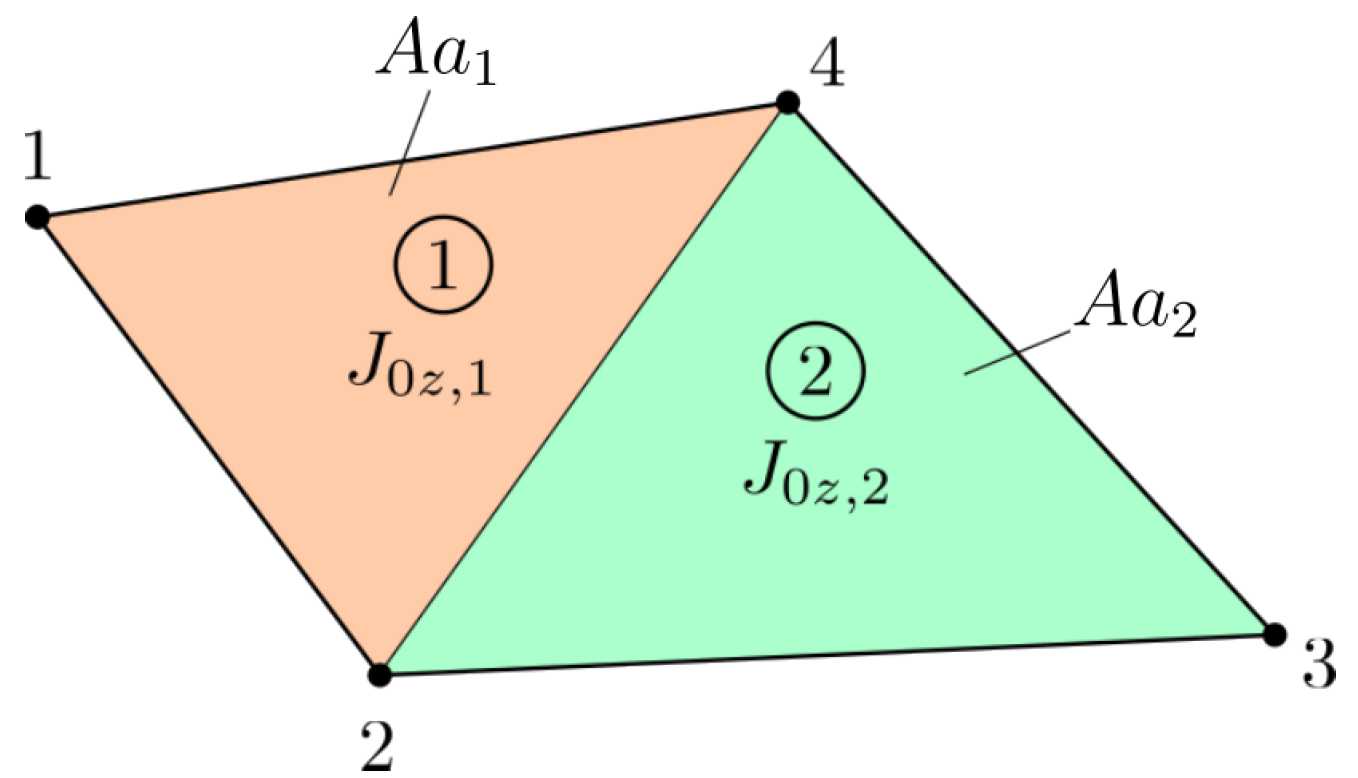
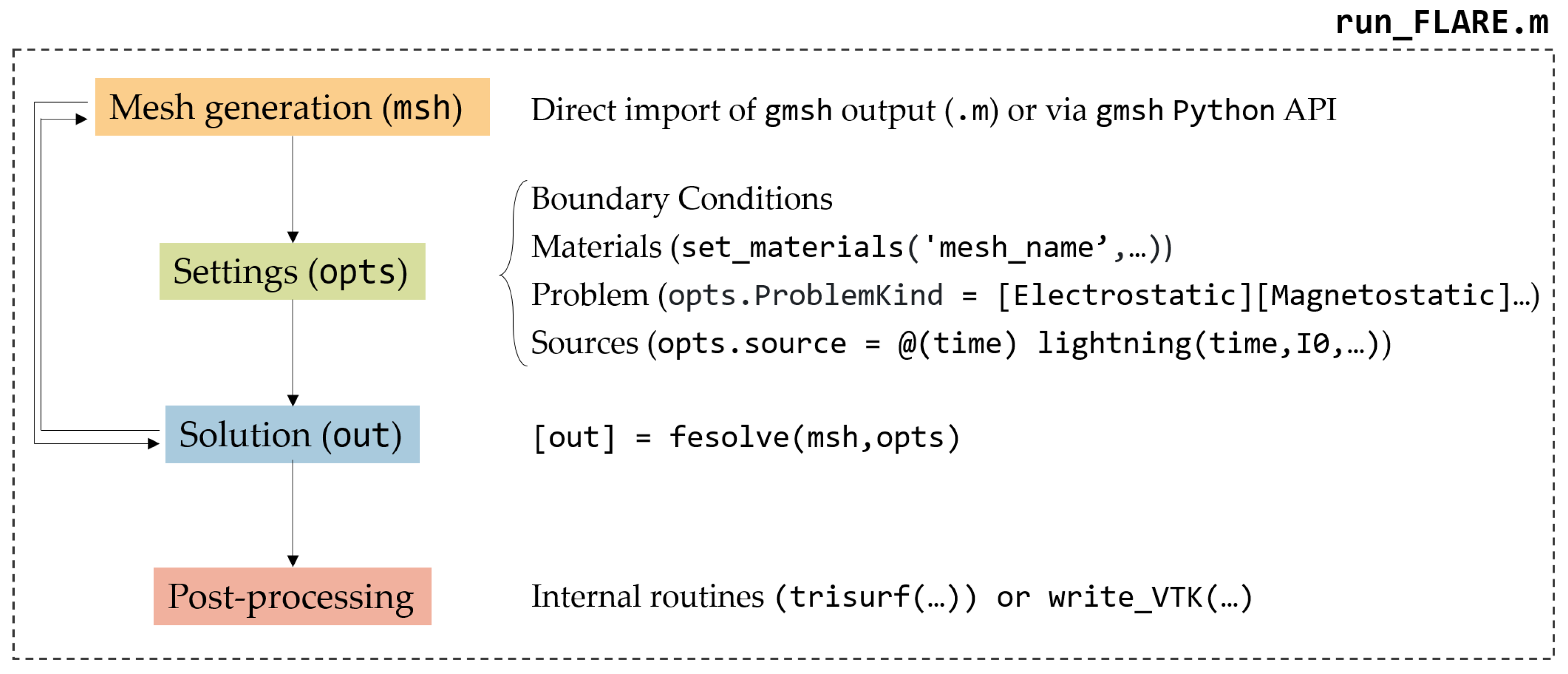

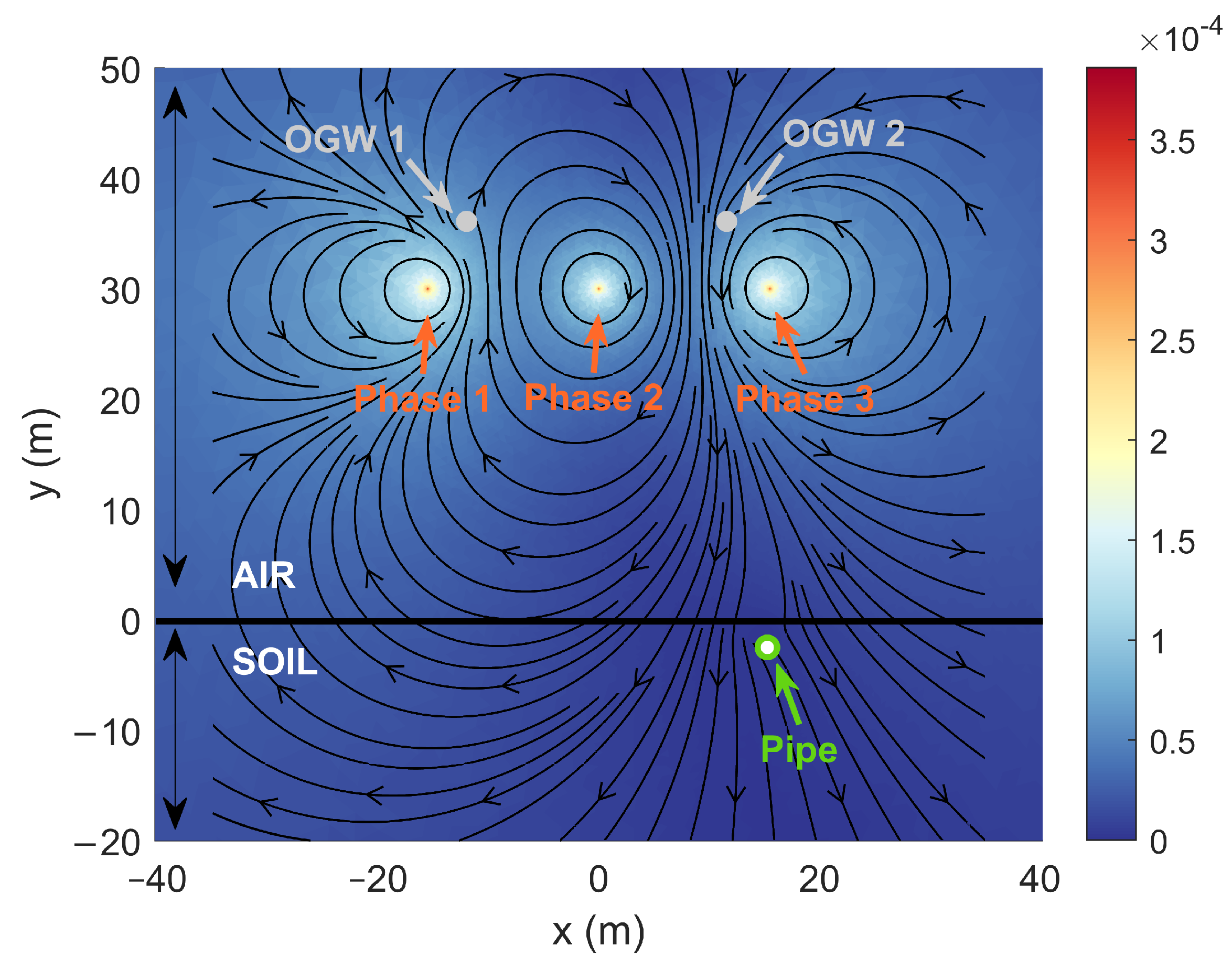
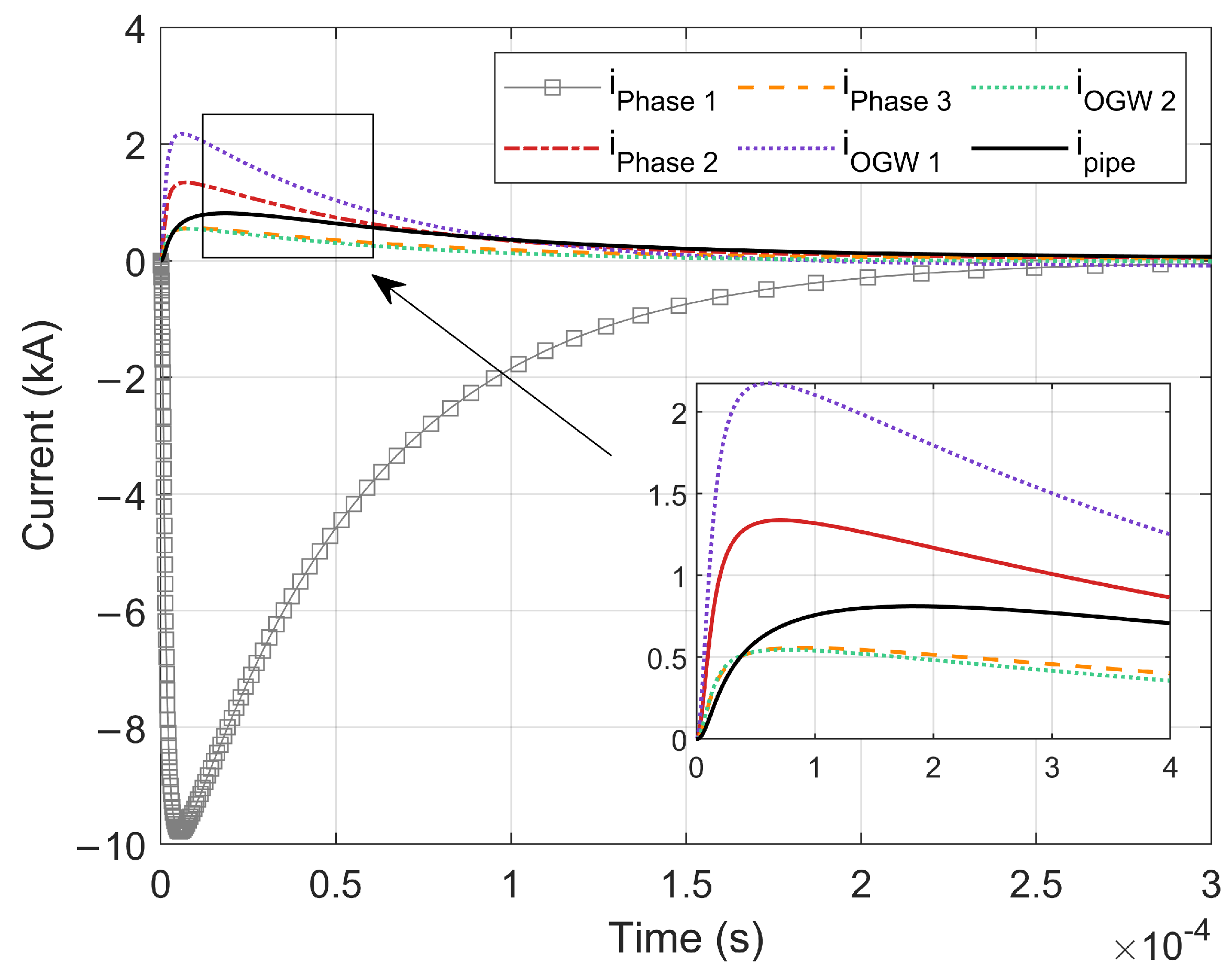
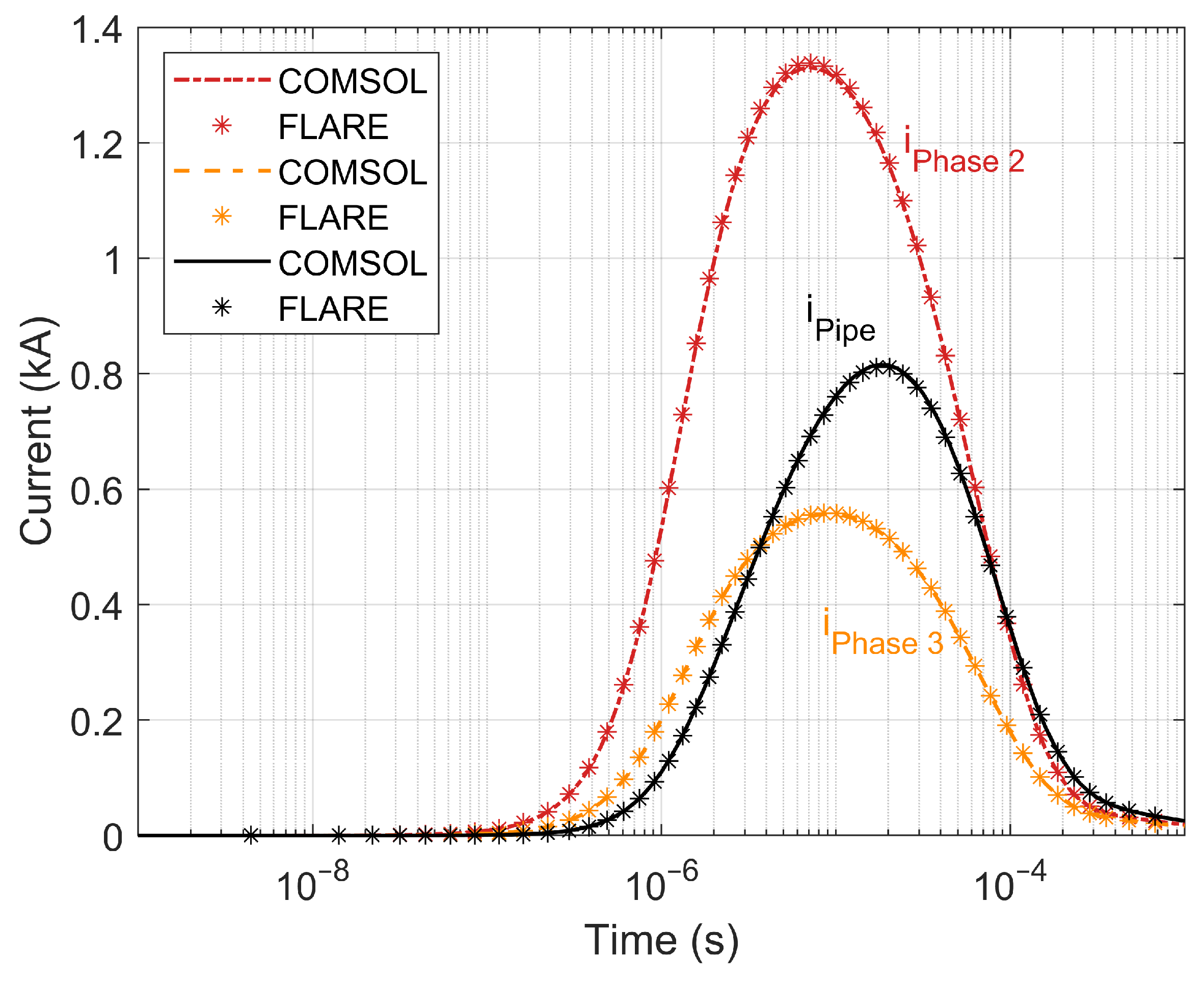
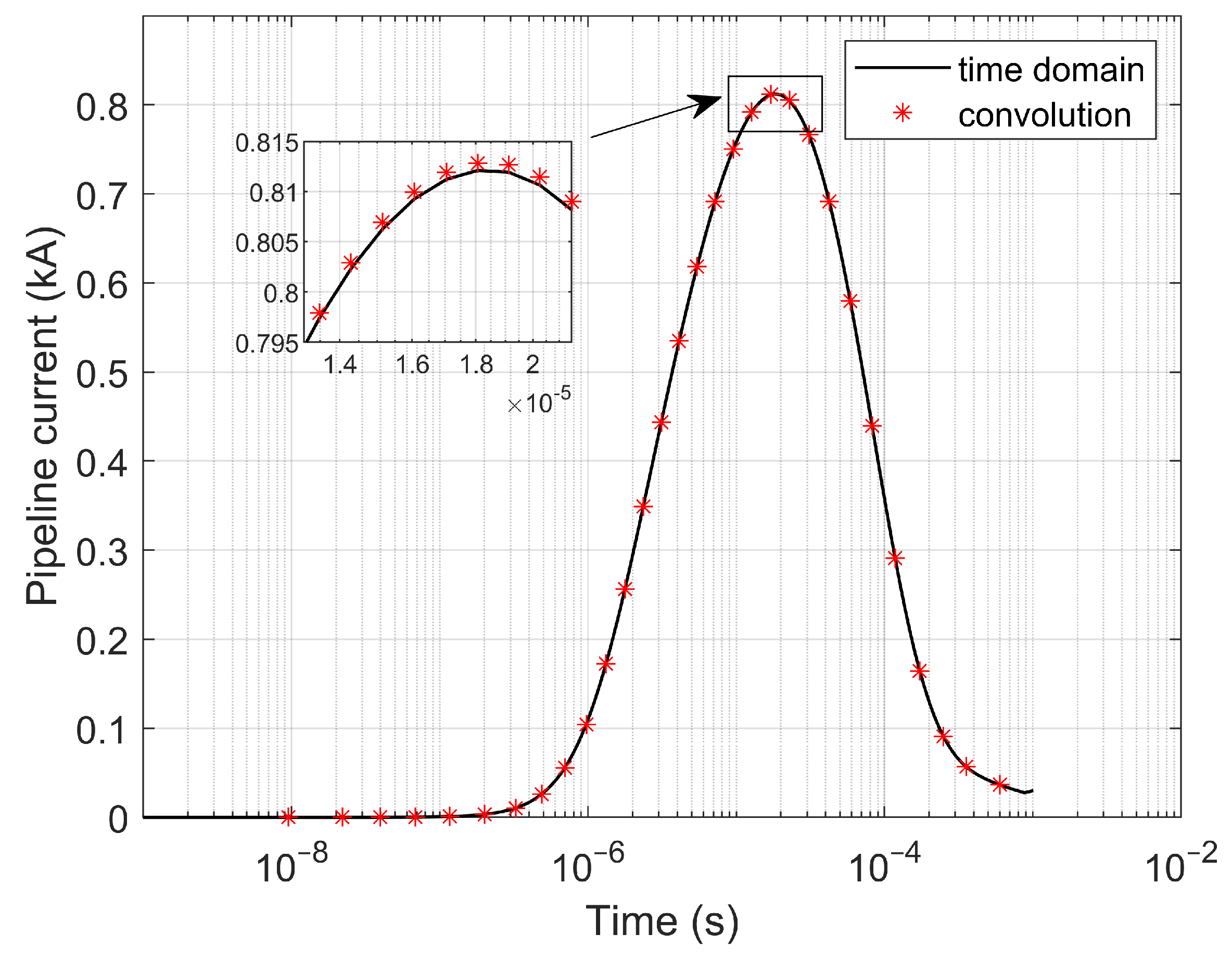
| Region | Current Magnitude (A) | Phase (deg) | ||||
|---|---|---|---|---|---|---|
| FLARE | COMSOL | 1 | FLARE | COMSOL | 1 | |
| OGW 1 | 12.2731 | 12.2730 | 0.0004 | −140.8317 | −140.9354 | 0.0736 |
| OGW 2 | 10.2212 | 10.2205 | 0.0074 | 42.3653 | 42.2765 | 0.2100 |
| pipe | 10.4912 | 10.4877 | 0.0332 | −10.7012 | −10.7105 | 0.0864 |
| Soil | 8.1174 | 8.1091 | 0.1023 | 166.3202 | 166.3265 | 0.0038 |
| Algorithm | Settings | Time (s) | |||
|---|---|---|---|---|---|
| = 2.64 × 10−9 | = 4.55 × 10−5 | ||||
| pipeline current (A) | |||||
| D’Amore et al. | Relative tolerance | 1.00 × 10−5 | −9.419 87 × 102 | −7.274 06 × 104 | 3.076 32 × 103 |
| M | n | % Error with respect to D’Amore et al. | |||
| Talbot | 4 | 4 | 1.60 × 10−2 | 3.87 × 10−2 | 1.23 × 101 |
| 8 | 8 | 1.45 × 10−5 | 3.75 × 10−6 | 7.59 × 10−3 | |
| 16 | 16 | 4.18 × 10−11 | 1.10 × 10−8 | 1.69 × 10−4 | |
| 32 | 32 | 3.33 × 10−12 | 1.29 × 10−7 | 2.50 × 10−3 | |
| 64 | 64 | 1.06 × 10−6 | 1.77 × 10−2 | 3.26 × 102 | |
| Euler | 4 | 9 | 6.05 × 10−1 | 2.67 × 10−1 | 1.26 |
| 8 | 17 | 1.27 × 10−3 | 6.54 × 10−4 | 5.12 × 10−3 | |
| 16 | 33 | 5.64 × 10−9 | 2.89 × 10−8 | 4.21 × 10−4 | |
| 32 | 65 | 9.50 × 10−7 | 5.89 × 10−4 | 1.15 × 102 | |
| 64 | 129 | 3.93 × 102 | 5.76 × 107 | 7.57 × 1011 | |
Disclaimer/Publisher’s Note: The statements, opinions and data contained in all publications are solely those of the individual author(s) and contributor(s) and not of MDPI and/or the editor(s). MDPI and/or the editor(s) disclaim responsibility for any injury to people or property resulting from any ideas, methods, instructions or products referred to in the content. |
© 2023 by the authors. Licensee MDPI, Basel, Switzerland. This article is an open access article distributed under the terms and conditions of the Creative Commons Attribution (CC BY) license (https://creativecommons.org/licenses/by/4.0/).
Share and Cite
Popoli, A.; Pierotti, G.; Ragazzi, F.; Sandrolini, L.; Cristofolini, A. FLARE: A Framework for the Finite Element Simulation of Electromagnetic Interference on Buried Metallic Pipelines. Appl. Sci. 2023, 13, 6268. https://doi.org/10.3390/app13106268
Popoli A, Pierotti G, Ragazzi F, Sandrolini L, Cristofolini A. FLARE: A Framework for the Finite Element Simulation of Electromagnetic Interference on Buried Metallic Pipelines. Applied Sciences. 2023; 13(10):6268. https://doi.org/10.3390/app13106268
Chicago/Turabian StylePopoli, Arturo, Giacomo Pierotti, Fabio Ragazzi, Leonardo Sandrolini, and Andrea Cristofolini. 2023. "FLARE: A Framework for the Finite Element Simulation of Electromagnetic Interference on Buried Metallic Pipelines" Applied Sciences 13, no. 10: 6268. https://doi.org/10.3390/app13106268
APA StylePopoli, A., Pierotti, G., Ragazzi, F., Sandrolini, L., & Cristofolini, A. (2023). FLARE: A Framework for the Finite Element Simulation of Electromagnetic Interference on Buried Metallic Pipelines. Applied Sciences, 13(10), 6268. https://doi.org/10.3390/app13106268









